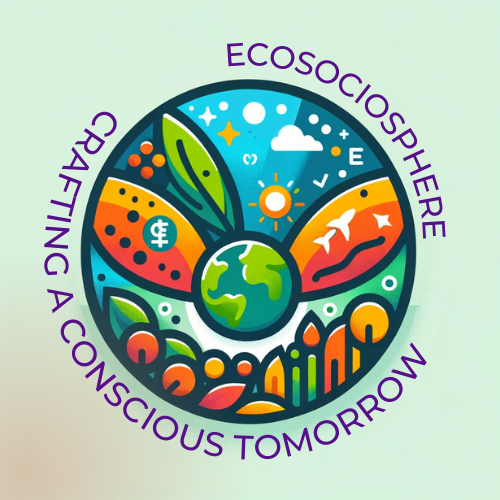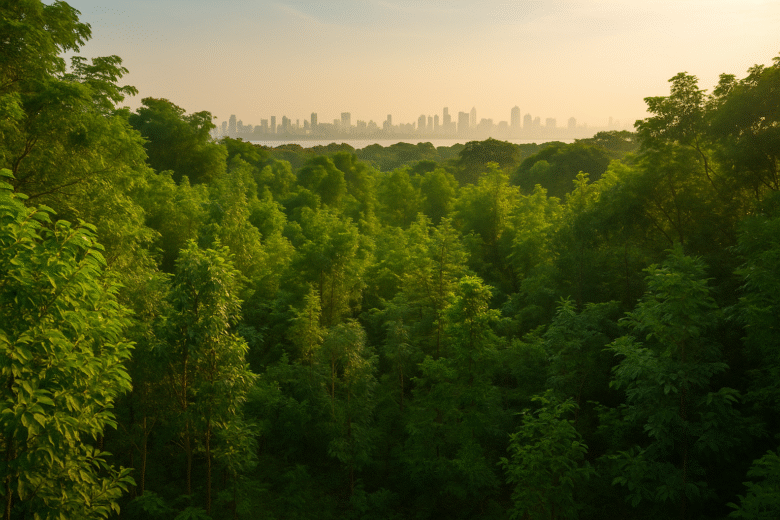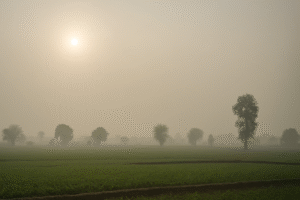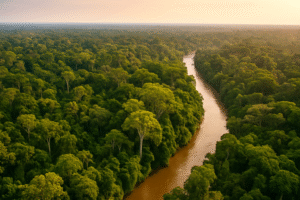Fun fact: In just three years, a barren dumping ground in Mumbai’s Uttan region has transformed into a dense green forest of over 8,600 trees — all grown using a method that promises to make nature heal at lightning speed.
There’s something poetic about a forest rising from a garbage heap. Mumbai’s Green Revolution: How a Garbage Dump Became a Forest isn’t just a catchy headline — it’s a real story of how the Mira-Bhayandar Municipal Corporation (MBMC) took a toxic eyesore and turned it into an ecological asset.
Once a wasteland filled with plastic, debris, and fumes, the Uttan dumping ground is now a thriving green oasis — a living laboratory for urban regeneration. Using the Miyawaki method, MBMC has planted 8,600 saplings from 49 native species, proving that even the most degraded lands can be reborn when policy, science, and community align.
This isn’t just about planting trees. It’s about rethinking how Indian cities handle waste, land, and climate resilience. In a country where “green cover” often means ornamental gardens or monoculture plantations, this small forest is a quiet revolution — one that blends smart planning with ecological integrity.
From Dump to Urban Forest: The Miyawaki Magic
Named after Japanese botanist Dr. Akira Miyawaki, the Miyawaki method involves dense planting of native species in multiple vertical layers — canopy, sub-canopy, shrubs, and ground cover — to mimic the natural structure of a forest. Unlike traditional tree planting, which can take decades to create a micro-ecosystem, Miyawaki forests mature in just three to five years.
At Uttan, MBMC used a carefully prepared soil mix of red soil, manure, cocopeat, neem powder, and vermicompost to regenerate the damaged ground. The saplings were planted closely together to encourage competition and vertical growth, while drip irrigation ensures efficient water use — critical for India’s increasingly erratic rainfall patterns.
What’s striking is that this isn’t a corporate project chasing publicity. It’s a municipal initiative, driven by a team that saw urban ecology not as an afterthought but as infrastructure. MBMC’s approach embodies what India’s cities urgently need — policy-backed, science-driven, community-supported green planning.
Why This Matters for Urban India
Indian cities are choking. From Delhi’s smog to Mumbai’s heat islands, urban ecosystems are collapsing under concrete and cars. According to India’s Ministry of Environment, Forest and Climate Change, the average per capita green space in Indian cities is below 2 square meters, far short of the World Health Organization’s (WHO) recommended 9 square meters.
Urban forests like Uttan’s offer a blueprint for change. They cool neighbourhoods, recharge groundwater, absorb carbon dioxide, and restore biodiversity — all while occupying minimal land. These patches may look small on a map, but collectively they act as lungs, sponges, and sanctuaries for cities that desperately need all three.
Even more importantly, they challenge India’s traditional development mindset, where growth often means destruction. For too long, waste dumps, wetlands, and mangroves have been treated as expendable spaces. The Uttan project forces us to imagine something radical: that ecological repair is not just possible but practical.
Policy Roots of a Green Revolution
To appreciate what MBMC achieved, we need to look at the broader policy context. Maharashtra’s State Action Plan on Climate Change calls for “nature-based solutions” to build resilience in cities — yet implementation has often lagged. Urban forestry projects typically die in the gap between enthusiasm and execution.
MBMC bridged that gap. By using the Swachh Bharat Mission (Clean India Mission) as a framework for site reclamation, and aligning it with Smart City and climate resilience goals, they turned a sanitation issue into an ecological success. This is governance that understands environmental repair as urban service delivery — not a hobby for NGOs or a CSR checkbox for corporations.
The corporation’s success also highlights an emerging idea in Indian urbanism: “Ecological Infrastructure.” Trees, wetlands, and soil aren’t luxuries — they’re functional systems that cool air, filter water, reduce flooding, and enhance mental health. Recognizing this in policy is key to transforming cities sustainably.
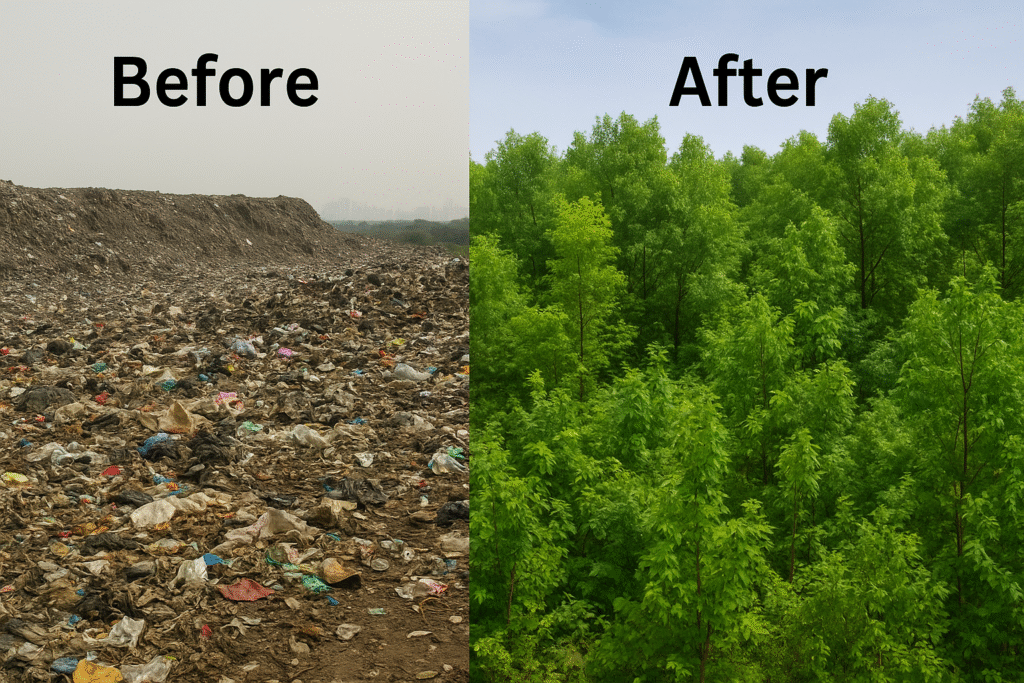
The Science Behind the Success
A forest’s health is more than its number of trees. The Miyawaki method emphasizes native species diversity, which ensures that plants thrive without excessive watering or chemical inputs. The Uttan forest’s 49 species were chosen to recreate a semi-evergreen ecosystem — resilient to both monsoon floods and summer droughts.
As roots deepen and the canopy thickens, soil temperature stabilizes, microbes multiply, and pollution drops. Within months, birds and insects return. Within years, carbon sequestration kicks in. According to estimates from similar Miyawaki forests, one acre can absorb 30 to 40 tons of carbon dioxide annually, depending on species composition.
This transformation, visible in satellite imagery, isn’t just aesthetic — it’s ecological healing at an urban scale. When replicated across multiple dumpsites, it could meaningfully offset local emissions and heat stress.
The Challenge of Maintenance
However, planting is the easy part; sustaining the forest is the true test. India’s public green projects often suffer from what experts call the “inauguration syndrome” — a burst of activity followed by neglect. MBMC must now ensure consistent watering, protection from grazing and encroachment, and data-driven monitoring.
A promising step would be to institutionalize urban forestry maintenance within municipal budgets, rather than depending on one-time grants. Partnerships with schools, resident welfare groups, or local green startups could ensure long-term ownership.
Urban ecology thrives not on applause, but on patience.
Beyond Mumbai: A Model for India’s Cities
The Uttan forest is not an isolated success. Across India, cities like Hyderabad, Pune, and Chennai are experimenting with Miyawaki plantations. Hyderabad’s civic body has created over 300 micro-forests, while Pune has transformed parts of its industrial belt into green corridors.
Yet, scale and authenticity remain challenges. Too often, “Miyawaki” is used as a buzzword for quick publicity — fast-growing saplings packed together without true species diversity or soil restoration. To replicate Mumbai’s success, cities must go beyond the headline and embrace the science.
Urban planners can integrate such forests into stormwater management, transport corridors, and housing layouts — turning green into a core design principle rather than a decorative afterthought. Imagine every ward having a micro-forest instead of an open dump; every overpass flanked by vertical greenery instead of billboards.
When Policy Meets People
At its heart, this story is not just about trees — it’s about people who believed in them. MBMC’s team included environmental engineers, horticulturists, and waste management experts who collaborated rather than competed. They didn’t wait for a global conference to tell them what to do; they looked at their backyard and acted.
This spirit of local governance innovation is where India’s true environmental revolution lies. When municipal bodies stop treating ecology as a checkbox and start treating it as a metric of governance, we get projects like Uttan.
And when citizens see the dump, they once avoided becoming a forest they now visit, something deeper changes — a civic relationship with nature begins to heal.
A Broader Reflection: What “Green” Really Means
The word “green” has been hijacked in modern India. It decorates billboards, conferences, and government slogans — yet rarely refers to living, breathing ecosystems. The Uttan project reclaims that word’s integrity.
True green isn’t cosmetic landscaping; it’s ecological functionality. It’s soil regeneration, carbon sequestration, water conservation, and biodiversity restoration. It’s when municipal policy evolves from maintaining parks to managing ecosystems.
In that sense, Mumbai’s green revolution is not just visual — it’s conceptual. It challenges the assumption that cities and forests must be separate realms. Perhaps the future of Indian urbanism lies not in more glass towers but in more breathing spaces.
Conclusion
From garbage dump to forest, Uttan’s transformation is more than a civic achievement — it’s a philosophical statement. It says that cities can grow and still give back to nature.
For policymakers, it’s a reminder that environmental repair is not a luxury — it’s survival infrastructure. For citizens, it’s an invitation to see urban forests as extensions of their own homes — as shared spaces that clean their air, cool their streets, and calm their minds.
If one municipal corporation can do this with limited funds and abundant will, imagine what could happen if India’s 4,000 urban bodies each reclaimed one landfill. We wouldn’t just be greening our cities; we’d be redefining what it means to live sustainably.
The Uttan forest may be small on a map, but its message is vast: there’s no such thing as waste land — only wasted imagination.
Author’s Note
As India’s cities sprawl and suffocate, projects like MBMC’s Uttan forest remind us that change need not wait for national schemes or international funding. It can start in a forgotten corner, with a few saplings, a few hands, and a shared vision.
Urban ecology is not about returning to the wild — it’s about inviting the wild back into our cities.
G.C., Ecosociosphere contributor.
References and Further Reading
- Times of India Photostory: Mumbai’s Green Revolution – MBMC Turns Uttan Dump into a Thriving Forest of 8,600 Trees
- Ministry of Environment, Forest and Climate Change – India State of Forest Report
- World Health Organization – Urban Green Space and Health Guidelines
- Hyderabad Miyawaki Urban Forestry Initiative – Greater Hyderabad Municipal Corporation Report
- Miyawaki Method Explained – United Nations Environment Programme Case Studies
- Smart Cities Mission – Government of India Policy Framework for Sustainable Urban Development
